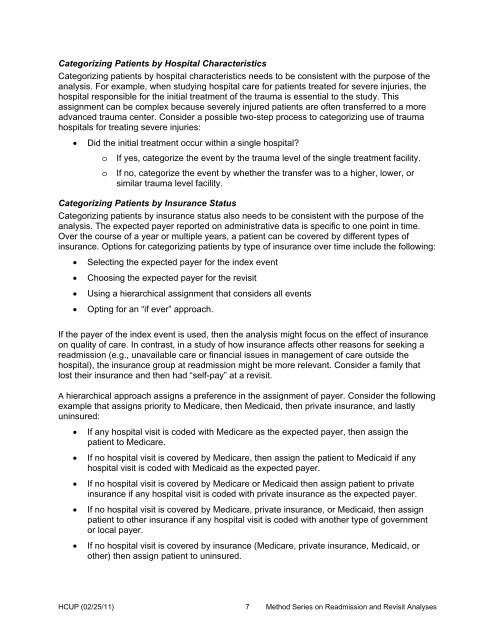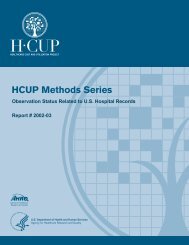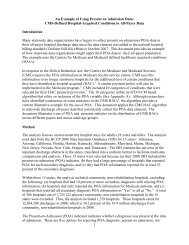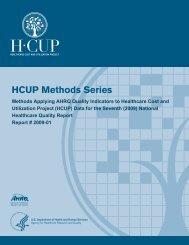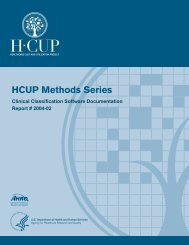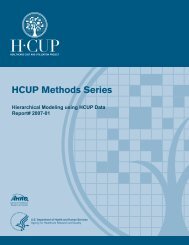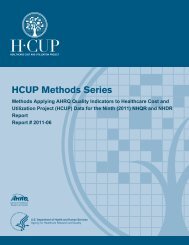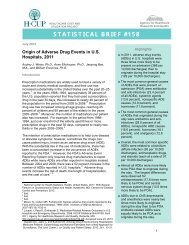Methodological Issues when Studying Readmissions and ... - HCUP
Methodological Issues when Studying Readmissions and ... - HCUP
Methodological Issues when Studying Readmissions and ... - HCUP
Create successful ePaper yourself
Turn your PDF publications into a flip-book with our unique Google optimized e-Paper software.
Categorizing Patients by Hospital CharacteristicsCategorizing patients by hospital characteristics needs to be consistent with the purpose of theanalysis. For example, <strong>when</strong> studying hospital care for patients treated for severe injuries, thehospital responsible for the initial treatment of the trauma is essential to the study. Thisassignment can be complex because severely injured patients are often transferred to a moreadvanced trauma center. Consider a possible two-step process to categorizing use of traumahospitals for treating severe injuries:• Did the initial treatment occur within a single hospital?o If yes, categorize the event by the trauma level of the single treatment facility.o If no, categorize the event by whether the transfer was to a higher, lower, orsimilar trauma level facility.Categorizing Patients by Insurance StatusCategorizing patients by insurance status also needs to be consistent with the purpose of theanalysis. The expected payer reported on administrative data is specific to one point in time.Over the course of a year or multiple years, a patient can be covered by different types ofinsurance. Options for categorizing patients by type of insurance over time include the following:• Selecting the expected payer for the index event• Choosing the expected payer for the revisit• Using a hierarchical assignment that considers all events• Opting for an “if ever” approach.If the payer of the index event is used, then the analysis might focus on the effect of insuranceon quality of care. In contrast, in a study of how insurance affects other reasons for seeking areadmission (e.g., unavailable care or financial issues in management of care outside thehospital), the insurance group at readmission might be more relevant. Consider a family thatlost their insurance <strong>and</strong> then had “self-pay” at a revisit.A hierarchical approach assigns a preference in the assignment of payer. Consider the followingexample that assigns priority to Medicare, then Medicaid, then private insurance, <strong>and</strong> lastlyuninsured:• If any hospital visit is coded with Medicare as the expected payer, then assign thepatient to Medicare.• If no hospital visit is covered by Medicare, then assign the patient to Medicaid if anyhospital visit is coded with Medicaid as the expected payer.• If no hospital visit is covered by Medicare or Medicaid then assign patient to privateinsurance if any hospital visit is coded with private insurance as the expected payer.• If no hospital visit is covered by Medicare, private insurance, or Medicaid, then assignpatient to other insurance if any hospital visit is coded with another type of governmentor local payer.• If no hospital visit is covered by insurance (Medicare, private insurance, Medicaid, orother) then assign patient to uninsured.<strong>HCUP</strong> (02/25/11)7Method Series on Readmission <strong>and</strong> Revisit Analyses


